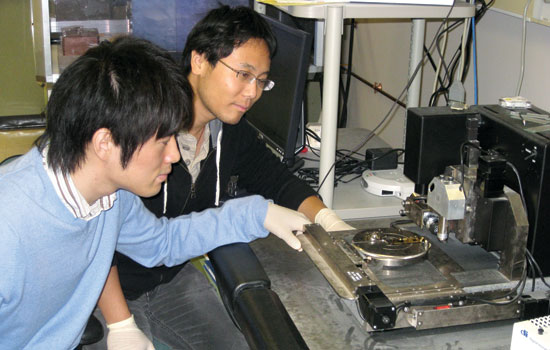‘Lunar’ rocks, craters no match for RIT moonbuggy
Human-Powered Vehicle Team takes first in NASA contest
Courtesy of D. Higginbotham (NASA/Marshall Space Flight Center)
Jacqueline Hill, a second-year biochemistry major, left, and Ben Strohman, a fifth-year mechanical engineering technology major and RIT Human-Powered Vehicle Team lead designer, traverse a simulated lunar-terrain course at the Great Moonbuggy Race, April 14, in Huntsville, Ala. RIT captured first place in the college division of the NASA-sponsored contest.
Next stop: the moon.
RIT’s Human-Powered Vehicle Team rolled to a first-place finish in the 14th annual Great Moonbuggy Race, April 13-14, at the U.S. Space & Rocket Center, in Huntsville, Ala.
The six-member student team finished with the fastest time—four minutes and 38 seconds, nine seconds ahead of its closest challenger—to earn the top spot in the college division of the NASA-sponsored contest. The victory was RIT’s first in eight trips to the competition.
Twenty-two teams from the United States, Puerto Rico and Canada built compact, lightweight and flexible—yet durable—two-passenger, human-powered vehicles designed to withstand the punishment of a half-mile simulated lunar-terrain course featuring craters, rocks, inclines, “lava” ridges and “lunar” soil.
“The team spent considerable time redesigning the moonbuggy to correct last year’s component failures to the drive-shaft system,” explains Stephen Boedo, associate professor of mechanical engineering in the Kate Gleason College of Engineering and the team’s advisor. “The course keeps getting tougher each year—it’s hard enough just to finish. I’m very proud of our team’s accomplishment, particularly the way students work together to implement engineering principles learned in the classroom.”
Adds Stephen Sweet, a third-year mechanical engineering major and team president, on benefits to students from participating in the event: “Every member of the team is exposed to an engineering project that is similar to what would be encountered in an industrial setting. We have to design and fabricate an entire vehicle on a limited budget, within a short timespan and with limited manpower. It is an invaluable experience that builds on classroom lessons and extends into the real world, giving us experience with design, testing, collaboration, economics, fabrication and prototyping.”









